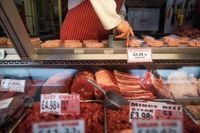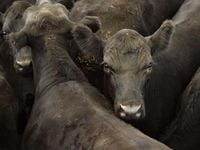Across grocery stores from London to Los Angeles, shoppers are feeling the sting of surging beef prices, a trend that’s reshaping budgets and mealtime traditions on both sides of the Atlantic. In July 2025, consumer prices for beef and veal in the UK shot up nearly 25% compared to a year earlier—the sharpest annual increase since official record-keeping began a decade ago, according to Bloomberg. This spike is not isolated: other staples like coffee, butter, and chocolate have jumped almost 20% in price over the past year, intensifying the UK’s ongoing cost-of-living squeeze.
But what’s really behind these jaw-dropping numbers at the butcher counter? For many, it’s a mix of bad weather, higher production costs, and a global set of pressures that are rippling through the food supply chain. In the United States, the world’s largest consumer and producer of beef, the story is just as dramatic. According to the most recent Consumer Price Index cited by The Washington Post, beef and veal prices soared 11.3% over the previous year in July—nearly four times the average increase for food overall in that period.
For industry insiders like Walter Avalos, a D.C.-based seller for a major U.S. deli producer, the price rollercoaster has become a weekly event. “We had to put at the bottom of our inventories that prices can change at any moment,” Avalos, 34, told The Washington Post. “It never used to be like that.” He’s not alone in changing habits. Once a daily feature on his family’s table, red meat is now rationed to once a week, a shift echoed by many Americans grappling with sticker shock.
So, what’s fueling this global beef inflation? The roots are deep and tangled. In the U.S., three years of severe drought—especially in powerhouse beef-producing states like Texas, Oklahoma, and Nebraska—have forced ranchers to slaughter cattle early, a move that temporarily boosted supply but decimated future herds. By 2025, cattle volumes had fallen to their lowest levels since 1951, according to U.S. Department of Agriculture data reported by Hearst Television. The drought’s grip has loosened in some places, but persistent dry pockets remain in Texas and Kansas, keeping pressure on already diminished herds.
Rebuilding those herds isn’t a quick fix. As Derrell Peel, a professor of agribusiness at Oklahoma State University, explained to The Washington Post, “It took several years to get here. It’s going to take several years to get out. Once you’re in this situation, there is nothing you can do to speed up the recovery.” Cattle have just one calf at a time, and with the population of replacement heifers down 3% in July 2025 compared to two years earlier, prices for young cattle are spiking too. Phil Durst, a farm educator at Michigan State, noted that the price of a standard calf rose from $1.48 per pound in 2018 to $3.22 by 2024, with expectations of hitting at least $4.40 this year.
Meanwhile, in the UK, the situation is compounded by bad weather and rising production costs, Bloomberg reported. These factors are making it even harder for farmers to keep up with demand, and the result is felt acutely by consumers already squeezed by inflation. The ripple effect extends to other household staples, with coffee, butter, and chocolate all notching double-digit price gains over the past year.
But weather and production costs aren’t the only culprits. In the U.S., tariffs are shaking up the market in unexpected ways. The Trump administration’s recent 50% tariff on Brazilian beef imports—a response to political developments in Brazil—has hit the world’s largest beef exporter and America’s top foreign supplier. According to USDA data cited by The Washington Post, Brazil sent more beef to the U.S. in the first half of 2025 than any other country, and imports from Brazil in May were five times higher than the same period last year. Importers rushed to get shipments in before the new tariffs took effect, but now, with the levies in place, prices are poised to climb even higher.
Australia, another major supplier, is also feeling the heat from new U.S. tariffs, while imports from Mexico have been halted due to a lethal cattle disease. The combined effect is a tightening of supplies just as demand remains strong. “That is obviously going to drive up costs as it relates to U.S. consumers over time,” noted an analyst interviewed by The Washington Post.
It’s not just macroeconomics and geopolitics at play. There are biological threats, too. As Damali Ramirez, a data researcher for Hearst Television, discovered, a parasite called the New World Screwworm is impacting cattle health and further complicating supply issues. “Most farmers said that consumer demand is still really high and their inventory is really low, which has made it really difficult for them to keep up with that high demand,” Ramirez explained. She also highlighted the increasing average age of American farmers, a demographic shift that could make the industry less resilient to shocks in the future.
Despite all this, Americans haven’t yet significantly cut back on beef consumption, according to S&P Global and USDA figures cited by The Washington Post. But experts warn that could change in 2026 if high prices persist. Some, like consumer Nico Bran, are adapting by cutting costs elsewhere in their grocery budgets rather than giving up beef. “Beef is a big priority,” said Yoni Vrotsos, a U.S. Navy pilot. He’s sticking with chicken for now, which has actually become more affordable this year, but says he won’t swap out beef entirely—unless prices rise by a staggering 40%.
For those looking for relief, chicken is a rare bright spot. Thanks to a bumper crop of corn and soybeans, feed costs have dropped, and chicken prices fell slightly between July 2024 and July 2025, according to CPI data. Fast-food chains have started promoting chicken dishes more aggressively, and some consumers are following suit, at least for now.
Still, the outlook for beef prices remains grim. Experts like Oklahoma State’s Peel say the road to recovery will be long, given the slow pace of herd rebuilding and the ongoing threat of climate-driven droughts. Meanwhile, global supply chains remain vulnerable to political shocks, disease outbreaks, and changing consumer habits.
For shoppers in both the UK and U.S., the message is clear: beef is becoming a luxury rather than a staple, and the forces driving up prices show no sign of abating soon. As consumers adjust their habits and budgets, the humble burger may become the latest casualty in the ongoing battle with inflation.


